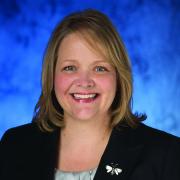Making Connections. That Was Fast ...

You are here
Late last summer, as our family prepared for back to school, it dawned on me that this is a special year for us. It is the last year that all three of my children are in elementary school. With Austin, Eli, and Isabel in sixth, fifth, and fourth grades respectively, I am in a state of shock when I think that we have officially grown out of early childhood and are veering wildly toward adolescent drama (but I will save that for another column).
At NAEYC we talk a lot about how quality early childhood education should exist in all settings and that its purpose should be both to keep young children safe while their parents work and to optimize their early learning and development. Beyond the mountains of research I’ve read in my professional capacity, I know this is true because it is what I experienced as a mother.
I was extremely fortunate throughout my children’s early years. When they were babies, I worked part-time, and their grandparents and aunt watched them on my workdays. Once there were three, we utilized in-home care. A little later, they were in a “traditional” public school setting that was far from typical, but should be the norm—an NAEYC-accredited, Reggio-inspired preschool. At another point, they were in a charter school Montessori program that was started by members of a Sikh community in Phoenix, Arizona. Clearly, my children had wonderfully rich and well-rounded early learning experiences— and I deeply appreciated knowing that they were thriving.
Now that this phase of my life as a mother has ended, I am reflecting on what I learned. These experiences taught me four crucial lessons.
-
Quality care is expensive and hard to come by. With three young children so close in age, the largest portion of our paychecks went to child care. We spent more per child than what it would have cost for each of them to attend a public university in Arizona. When choosing care, we toured many programs, interviewed directors and staff, and observed classrooms. When we hired nannies, we conducted background checks and observed them with our children. We are privileged. We had the flexibility in our finances and our schedules to have good choices. Most families do not get to make such choices. Across the country, our communities desperately need more options for affordable, accessible, and high-quality care.
-
Family engagement matters. I loved those years, but my goodness they were stressful and isolating. From fussy babies to reports that my 3-year-old bit a child, I needed help! Great family engagement goes beyond parents volunteering in the classroom or bringing in materials for a project. Programs that create community help families understand learning objectives (and how families can extend learning at home) and foster meaningful conversations with teachers and administrators. Such programs provide opportunities for families to get to know—and support—one another as well.
-
Caregivers and educators matter almost as much as families. All of the caregivers and educators in my children’s lives were loving and nurturing, and they knew how to create engaging and inspiring environments. In our home, there were cities built out of blocks, hours spent reading the same board books over and over again, and all sorts of tasty treats cooked in our kitchen. The children still remember their preschool teachers and can recall their dispositions and interactions. Classroom environments in preschool were creative and intentional, with a touch of whimsy. The children made paper from scratch and observed and documented caterpillars morphing into butterflies—projects that introduced science, math, and literacy in developmentally appropriate ways. In K–3, the children participated in Socratic discussions, debating and questioning with confidence and maturity. Families attended international nights, when teachers transformed their classrooms into public markets and wilderness scenes so we could experience cultural sights, tastes, and sounds from around the world.
-
Kindergarten through third grade really is early childhood education. Admittedly, there was an abrupt change after preschool. K–3 classrooms and educators are at the nexus of developmental science and academic preparation. I watched the educators, some with master’s degrees in early learning, work mightily to address learning standards while maintaining developmentally appropriate environments—the children learned to count by 10s to 100 with rocks in the mud! They took naps in kindergarten, and they cultivated gardens. My observation is that primary grade curriculum is most effective when teachers have access to optimal professional development and resources; of course, this depends on school administrators understanding the science of early learning and creating supportive teaching environments.
I have always been an advocate for early childhood education—first in college, then working on political campaigns and in child advocacy organizations and nonprofits. But it became personal for me when I had children. My husband and I had access to all the supports we needed. I am personally driven by knowing that all families share similar aspirations for their children; however, without the fundamental supports and structures available, far too many children are falling behind. That is why I am at NAEYC, and that is why the association’s vision is that “all young children thrive and learn in a society dedicated to ensuring they reach their full potential.” We cannot rest until all families have equitable access to developmentally appropriate, high-quality early care and education.
Rhian Evans Allvin is the chief executive officer of NAEYC. She is responsible for guiding the strategic direction of the organization as well as overseeing daily operations. Before joining NAEYC, Evans Allvin was a guiding force in Arizona’s early childhood movement for more than 15 years, including serving as CEO of Arizona's First Things First.
